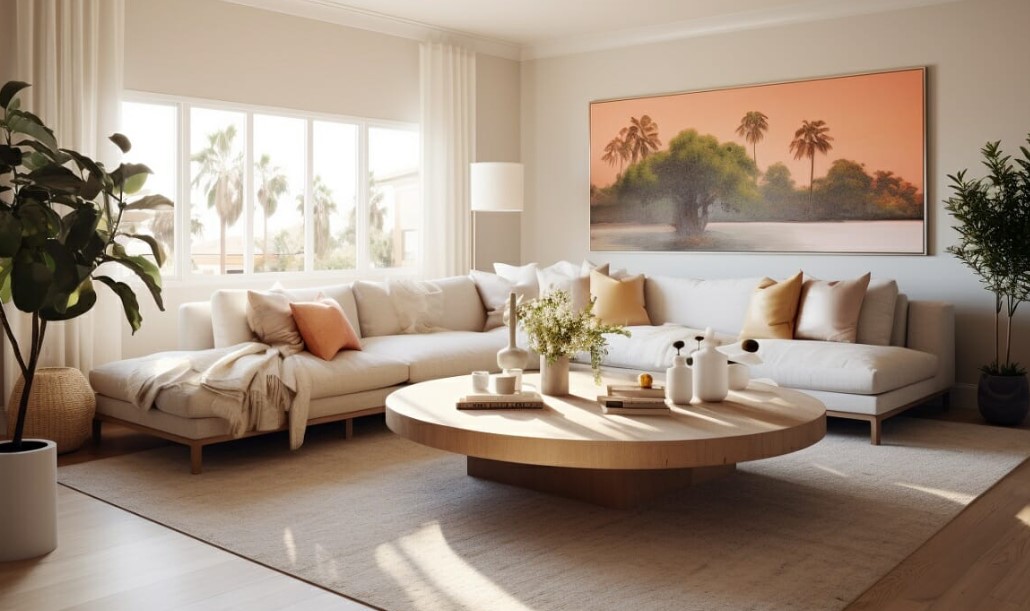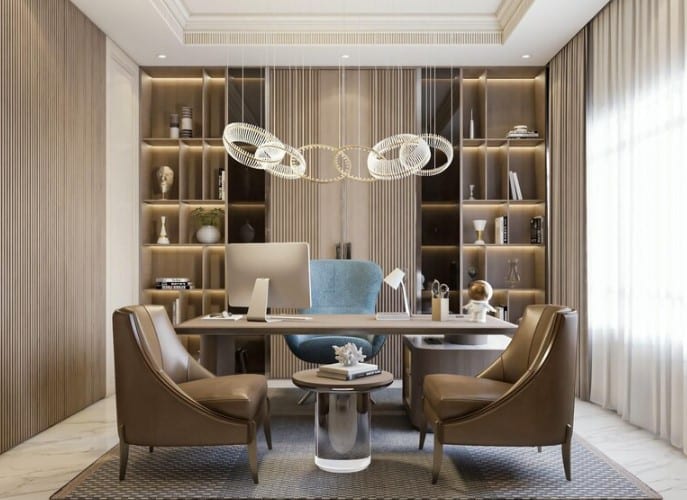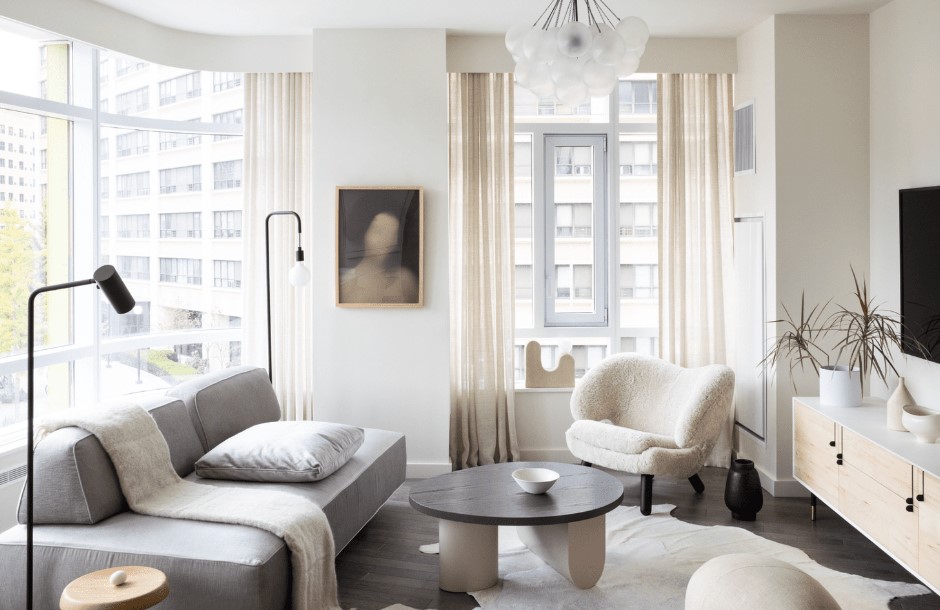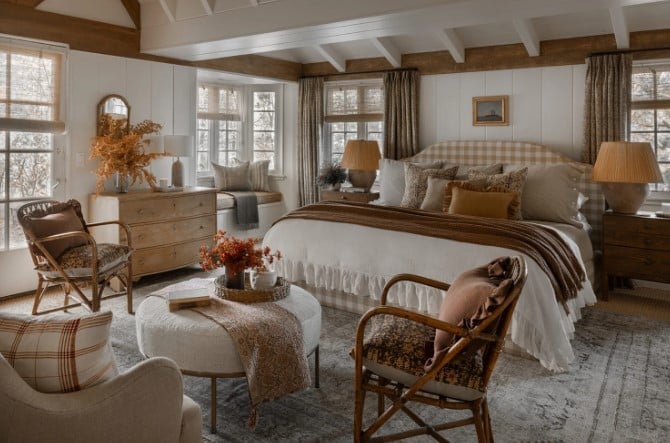Living room interior design inspiration – The concept of eco-friendly interior design has grown beyond a mere trend to become an essential part of creating a sustainable and healthy living environment.
As people become more aware of their impact on the planet, the demand for environmentally friendly products that do not compromise on style or comfort has increased significantly.
This site havenblueprint delves into the best eco-friendly interior design products that can transform your home into a model of sustainability and elegance living room interior design inspiration.
What is Eco-Friendly Interior Design?
Eco-friendly interior design focuses on using materials and practices that minimize environmental impact while maximizing the well-being of the occupants.
This approach integrates sustainable materials, energy-efficient products, and designs that reduce waste and promote a healthier living space.
One of the key aspects of eco-friendly interior design is the selection of sustainable materials. These include options like bamboo, cork, and reclaimed wood, which are renewable and have a lower environmental footprint compared to traditional materials.
Additionally, using low-VOC (volatile organic compounds) paints and finishes helps to improve indoor air quality, making the space healthier for occupants.
The focus is not just on the materials themselves, but also on their lifecycle, from production to disposal, ensuring that every element contributes to a sustainable future.
You can also read : Eco-Friendly Interior Design Tips and Products
The Benefits of Eco-Friendly Interior Design

Eco-friendly interior design offers numerous benefits that go beyond just helping the environment. Here are some key advantages:
- Improved Indoor Air Quality: Many traditional building materials and furnishings contain harmful chemicals that can off-gas into the air, leading to poor indoor air quality. Eco-friendly products, such as non-toxic paints and natural materials, significantly reduce the presence of these harmful chemicals, resulting in a healthier living environment.
- Sustainability: By choosing materials that are renewable, recycled, or responsibly sourced, you contribute to the preservation of natural resources and reduce waste. This, in turn, helps to lower the carbon footprint of your home.
- Energy Efficiency: Eco-friendly design often includes energy-efficient appliances, lighting, and insulation, which can lead to significant savings on utility bills. These products not only help reduce energy consumption but also contribute to a more sustainable lifestyle.
- Longevity and Durability: Sustainable materials are often more durable and long-lasting, reducing the need for frequent replacements and repairs. This longevity translates to cost savings over time and less waste.
You can also read : Top Minimalist Interior Design Ideas and Products
Top 5 Eco-Friendly Interior Design Products
1. Reclaimed Wood Furniture
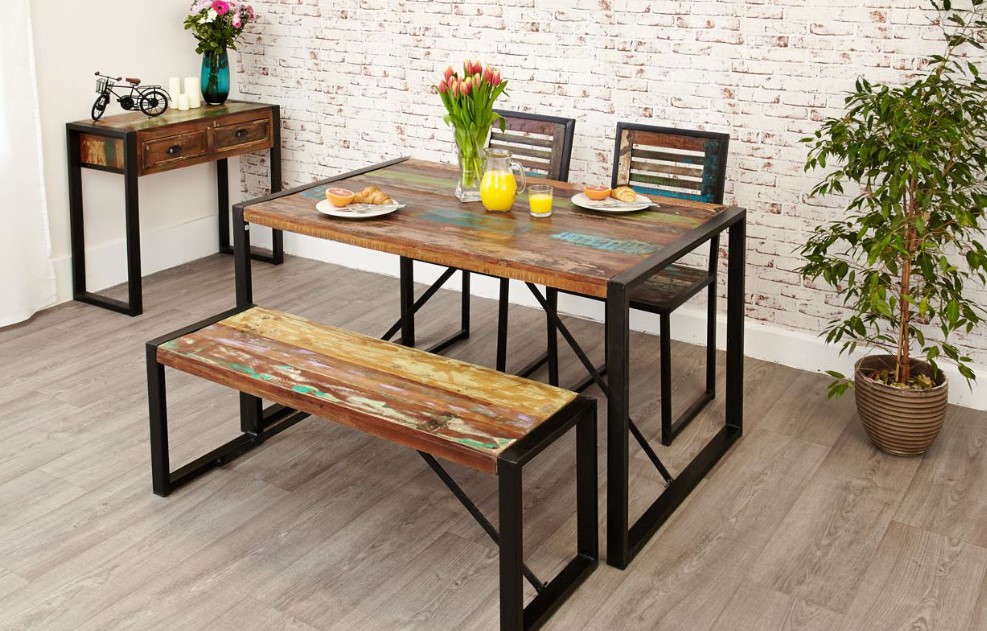
Reclaimed wood furniture is one of the most popular choices for those looking to incorporate eco-friendly materials into their homes.
This type of furniture is crafted from wood that has been salvaged from old buildings, barns, or other structures, giving it a unique, rustic appearance while conserving natural resources living room interior design inspiration.
In addition to its environmental benefits, reclaimed wood furniture offers a distinct aesthetic that adds character and warmth to any space.
Each piece often has its own story, with unique grain patterns, knots, and weathered textures that cannot be replicated by new wood. This individuality makes reclaimed wood furniture not only sustainable but also a stylish addition to any home decor.
Moreover, reclaimed wood is known for its durability and strength, often outperforming newer woods that have not been seasoned by time.
Furniture made from reclaimed wood is typically more resistant to warping and cracking, ensuring longevity. This resilience makes it a practical choice for high-use areas, like dining tables or kitchen islands.
- Material Overview: Reclaimed wood is often more robust than new wood because it comes from older trees that grew slowly and developed dense, strong grain structures. This makes reclaimed wood furniture not only beautiful but also exceptionally durable.
- Environmental Impact: By using reclaimed wood, you reduce the demand for new timber, which helps to conserve forests and reduce deforestation.
- Aesthetic Appeal: Each piece of reclaimed wood furniture is unique, with its own history and character, making it a conversation piece in any home.
Where to Buy:
Etsy offers a wide selection of reclaimed wood furniture, ranging from dining tables to bed frames.
- Price Range: $300 – $2000, depending on the size and craftsmanship of the piece.
- Pros: Sustainable, unique, durable, adds character to any room.
- Cons: Can be more expensive than mass-produced furniture, limited style options.
- Use Case: Ideal for rustic, industrial, or farmhouse-themed interiors where you want to create a warm, inviting atmosphere with a touch of history.
2. Bamboo Flooring
Bamboo flooring is an excellent alternative to traditional hardwood floors. Fast-growing grass that can be harvested without killing the plant, making it one of the most renewable resources available.
Bamboo flooring is not only eco-friendly but also highly durable and resilient, making it suitable for high-traffic areas in the home.
It is naturally resistant to moisture and insects, and with proper care, bamboo floors can last as long as traditional hardwood floors.
Additionally, bamboo flooring is available in a variety of finishes, colors, and grain patterns, allowing it to complement both modern and traditional interior designs.
Its ease of installation, often coming in click-lock or tongue-and-groove planks, makes it a popular choice for DIY projects.
Bamboo’s combination of sustainability, durability, and aesthetic appeal makes it a great choice for environmentally conscious homeowners.
- Material Overview: Bamboo flooring is known for its strength, durability, and aesthetic appeal. It is available in various colors and finishes, allowing it to fit seamlessly into any design style, from contemporary to traditional.
- Environmental Impact: Bamboo grows quickly and requires minimal pesticides or fertilizers, making it an environmentally friendly choice. Its rapid growth also means it can be harvested more frequently than traditional hardwoods, reducing deforestation.
- Aesthetic Appeal: Bamboo flooring offers a sleek, modern look that can complement a wide range of interior design styles. It is available in both natural and engineered forms, with options for different finishes and colors.
Where to Buy: Cali Bamboo is a leading provider of high-quality bamboo flooring, known for its durability and eco-friendly practices.
- Price Range: $3 – $8 per square foot, depending on the type and finish of the bamboo.
- Pros: Renewable, durable, easy to maintain, available in various styles.
- Cons: Can be susceptible to water damage and may scratch easily.
- Use Case: Perfect for high-traffic areas like living rooms, hallways, and bedrooms where durability is essential, and a natural aesthetic is desired.
3. Non-Toxic Paint
Traditional paints can release VOCs (volatile organic compounds) into the air, which can cause health problems ranging from headaches to respiratory issues.
Non-toxic paints are made from natural ingredients and contain little to no VOCs, making them a healthier choice for your home.
Choosing non-toxic paint not only enhances the indoor air quality of your home but also contributes to a more sustainable living environment.
These eco-friendly alternatives come in a variety of colors and finishes, allowing you to achieve the desired aesthetic without compromising your health.
Many non-toxic paints are also free from harsh chemicals, making them safer for families, pets, and the environment.
By opting for non-toxic paint, you can confidently refresh your space while promoting a healthier lifestyle and reducing your carbon footprint.
- Material Overview: Non-toxic paints are water-based and made from natural ingredients like clay, milk proteins, and plant-based oils. They provide excellent coverage and come in a wide range of colors and finishes.
- Environmental Impact: By choosing non-toxic paints, you reduce the emission of harmful chemicals into the air, contributing to better indoor air quality and less environmental pollution.
- Aesthetic Appeal: Non-toxic paints offer the same color vibrancy and finish quality as traditional paints, with the added benefit of being safer for your health.
Where to Buy: ECOS Paints specializes in non-toxic, eco-friendly paints that are free from harmful chemicals.
- Price Range: $40 – $75 per gallon, depending on the color and finish.
- Pros: Non-toxic, low odor, wide color selection, environmentally friendly.
- Cons: Higher cost compared to conventional paints, may not be as widely available in local stores.
- Use Case: Ideal for all interior spaces, especially in homes with children, pets, or individuals sensitive to chemicals. Non-toxic paints are also a great choice for nurseries and bedrooms where a healthy environment is crucial.
4. Cork Wall Tiles

Cork is a renewable material harvested from the bark of cork oak trees. It regenerates quickly, making it a sustainable choice for various applications, including wall tiles.
Cork wall tiles offer excellent insulation, soundproofing, and a unique, natural look that adds warmth and texture to any room.
- Material Overview: Cork is lightweight, durable, and naturally resistant to mold, mildew, and pests. It provides excellent thermal and acoustic insulation, making it an ideal material for walls in both residential and commercial spaces.
- Environmental Impact: Cork is harvested without harming the tree, allowing it to continue growing and absorbing carbon dioxide. This makes cork a highly sustainable material with a low environmental footprint.
- Aesthetic Appeal: Cork wall tiles come in various textures and colors, allowing for creative and personalized interior designs. They can be used to create feature walls, accent areas, or even entire rooms with a warm, natural vibe.
Where to Buy: Modwalls offers a range of stylish cork wall tiles in different designs and colors.
- Price Range: $10 – $20 per square foot, depending on the design and thickness.
- Pros: Renewable, soundproofing, insulating, naturally resistant to mold and mildew.
- Cons: Can be more expensive than other wall covering options, limited design options compared to traditional materials.
- Use Case: Ideal for home offices, studios, bedrooms, and living areas where sound insulation is important. Cork wall tiles also add a natural, eco-friendly aesthetic that complements modern, minimalist, or rustic design styles.
5. Recycled Glass Countertops
Recycled glass countertops are a stylish and sustainable alternative to traditional stone or laminate options.
These countertops are made from post-consumer glass that is crushed, melted, and reformed into a durable, vibrant surface that can be used in kitchens, bathrooms, and other areas of the home.
- Material Overview: Recycled glass countertops are known for their unique appearance, combining the beauty of glass with the strength of solid surfaces. They are available in a variety of colors and patterns, allowing for customized designs.
- Environmental Impact: By using recycled glass, these countertops help reduce waste in landfills and minimize the demand for new raw materials. The production process is also less energy-intensive compared to traditional countertop materials.
- Aesthetic Appeal: Recycled glass countertops offer a distinct look with a glossy finish that reflects light beautifully. They can be customized to match any color scheme, making them a versatile choice for modern and contemporary interiors.
Where to Buy: Vetrazzo specializes in recycled glass countertops, offering a wide range of colors and designs living room interior design inspiration.
- Price Range: $75 – $150 per square foot, depending on the color, pattern, and thickness of the glass.
- Pros: Eco-friendly, unique appearance, durable, customizable.
- Cons: Higher cost than traditional countertops, can chip or crack if not properly maintained.
- Use Case: Ideal for kitchens and bathrooms where you want to make a bold, eco-friendly design statement. Recycled glass countertops are also great for those who value sustainability without sacrificing style.
You can also read : Coastal Interior Design Ideas and Essentials
How to Choose and Buy Eco-Friendly Interior Design Products
When selecting eco-friendly products for your home, it’s important to consider both the material and the company’s commitment to sustainability. Here are some tips to help you make the best choices:
- Look for Certifications: Check for certifications like FSC (Forest Stewardship Council) for wood products, Green Seal for paints, and Cradle to Cradle for various eco-friendly products. These certifications ensure that the products meet high environmental and health standards.
- Research the Brand: Investigate the brand’s sustainability practices, including their sourcing of materials, manufacturing processes, and packaging. Companies that prioritize sustainability often provide transparency about their practices.
- Consider Longevity: Opt for products that are not only eco-friendly but also durable and long-lasting. This reduces the need for frequent replacements, saving you money and reducing waste.
- Shop Online: Many eco-friendly products are available online, with detailed descriptions of their environmental benefits. Websites like EarthHero, Wayfair, and Amazon offer a wide range of sustainable options.
- Visit Local Stores: If you prefer to see products in person, visit home improvement stores like Home Depot and Lowe’s, which often carry eco-friendly options. Additionally, local boutiques specializing in sustainable products can provide unique, high-quality items.
You can also read : Smart Solutions for Small Apartment Interior Design
Why Invest in Eco-Friendly Interior Design?
Investing in eco-friendly interior design products is not just about creating a beautiful home; it’s about making a conscious choice to live more sustainably. Here’s why you should consider making the switch:
- Environmental Responsibility: By choosing sustainable products, you contribute to the preservation of natural resources and reduce your home’s carbon footprint.
- Health Benefits: Eco-friendly products often have fewer harmful chemicals, making your home a safer place for you and your family.
- Long-Term Savings: Many eco-friendly products, such as energy-efficient lighting and durable materials, offer long-term cost savings through reduced energy bills and fewer replacements.
- Supporting Ethical Companies: By purchasing from companies that prioritize sustainability, you support ethical business practices and encourage the production of more eco-friendly products.
Frequently Asked Questions
Q1: What are the best materials for eco-friendly interior design?
A1: Some of the best materials for eco-friendly interior design include reclaimed wood, bamboo, cork, recycled glass, and non-toxic paints. These materials are sustainable, durable, and reduce environmental impact while offering aesthetic and functional benefits.
Q2: Are eco-friendly interior design products more expensive?
A2: While some eco-friendly products may have a higher upfront cost, they often provide long-term savings through durability, energy efficiency, and reduced need for replacements. Additionally, the environmental and health benefits make them a worthwhile investment.
Q3: Where can I buy eco-friendly interior design products?
A3: Eco-friendly products can be purchased online through retailers like Wayfair, Amazon, and specialized sustainable stores like EarthHero. You can also find them at local home improvement stores such as Home Depot and Lowe’s.
Choosing eco-friendly interior design products is a powerful way to create a home that reflects your commitment to sustainability.
Whether you’re renovating a room or starting from scratch, these products provide a perfect blend of style, functionality, and environmental responsibility living room interior design inspiration.
Start your journey to a more sustainable home today by exploring these top eco-friendly interior design options.
